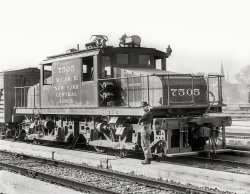
MAY CONTAIN NUTS

Search Shorpy
SHORPY ART

Framed or unframed, desk size to sofa size, printed by us in Arizona and Alabama since 2007. Explore now.
Join and Share
Ad-Free Shorpy
Shorpy is funded by you. Patreon contributors get an ad-free experience.
Learn more.

Recent comments
- Baldwin 62303
- Baldwin VO-1000
- Cold
- No expense spared
- Tough Guys
- Lost in Toyland
- And without gloves
- If I were a blindfolded time traveler
- Smoke Consumer Also Cooks
- Oh that stove!
- Possibly still there?
- What?!?
- $100 Reward
- Freeze Frame
- Texas Flyer wanted
- Just a Year Too Soon
- WWII -- Replacing men with women at the railroad crossing.
- Yes, Icing
- You kids drive me nuts!
- NOT An Easy Job
- I wonder
- Just add window boxes
- Icing Platform?
- Indiana Harbor Belt abides
- Freezing haze
- Corrections (for those who care)
- C&NW at Nelson
- Fallen Flags
- A dangerous job made worse
- Water Stop
Member Photos
The Shorpy
Print Emporium
Print Emporium
Search Shorpy
Search results -- 30 results per page
- Swamp Root: 1905
- ... field, home of the Binghamton Mets.
(Panoramas, DPC, Railroads) ... Posted by Dave - 08/21/2012 - 5:56pm -
![Swamp Root: 1905 Binghamton, New York, circa 1905. "Kilmer factory." The wellspring of Dr. Kilmer's Swamp Root, a popular patent medicine. The building was also the temporary headquarters of another Kilmer enterprise, the Binghamton Press newspaper. Panorama of two 8x10 inch glass negatives. View full size.
Why?What exactly were these guards for around the tree trunks? I've seen squirrels do amazing things and getting past those would be a cinch!
[Horses nibble. - Dave]
DetailsNo awnings above the second floor, sorry, folks. Interesting detail of brackets at the cornice line, how they line up with the wall below. What's the picture of a building in the storefront, just to the left of the corner entrance. Nice looking building, wonder, is it still there?
15 Herbal IngredientsDr. Kilmer blended 15 herbal ingredients for Swamp-Root: from South Africa, North and South America, Europe, the Middle East, Tibet, and North-west China, into a balanced formula that benefits the digestive, respiratory, and nervous systems.
Solidly BuiltLooks like Dr. Kilmer's building is still there, as is the Erie RR Station referred to on the sign:
Dr. Kilmer's Virginia EstateI grew up not too far from where Dr. Kilmer had an estate on the Rappahannock River in Virginia. The name of the community that grew up around the farm where he trained his Kentucky Derby horses is called Remlik, which is, of course, Kilmer spelled backward. The area is still called Remlik and until recently there was a Remlik post office.
Yup, still thereDeeGee, yes, the Kilmer Building is still there. It houses a bar & grill called Remliks, among other things. The railroad station is there too, but no longer functions as a station - bunch of different businesses in and out of the space - I think it's a hairdresser right now? Not sure. Just down the street is the AAA ball field, home of the Binghamton Mets.
(Panoramas, DPC, Railroads)](https://www.shorpy.com/files/images/SHORPY_Binghamton_Panorama.thumbnail.jpg)
- Amarillo Yardmaster: 1943
- ... brought back.
(The Gallery, Kodachromes, Jack Delano, Railroads) ... Posted by Dave - 08/10/2012 - 4:15pm -
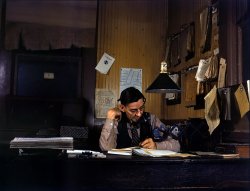
- Philadelphia Rapid Transit: 1906
- ... even moreso today.
(The Gallery, DPC, Philadelphia, Railroads) ... Posted by Dave - 08/14/2014 - 3:05pm -
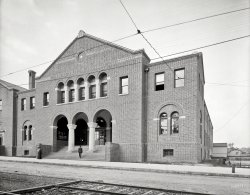
- T-Mail: 1912
- ... Reading. I was 10 or 11.
(The Gallery, Harris + Ewing, Railroads) ... Posted by Dave - 08/27/2012 - 11:54am -
![T-Mail: 1912 1912. "Post Office Department. Hupp Auto Railway Service" (i.e., Hupp Automatic Mail Exchange, a system for transferring mail bags to and from a moving train). Harris & Ewing Collection glass negative. Note the two utility poles at left that have been scratched off the negative. View full size.
What am I seeing?Besides the thumbprint, what is up with what appears to be two poles to the left of the stairs. On the right one I "see" a pair of praying hands and on the left Bambi's head . . . or maybe Elvis. Must you keep playing with my mind? I have so little of it left.
Mail catcherAll of the mail delivery devices I ever saw when I was growing up had only one bag holder. I don't see how a mail clerk could catch more than one bag and get it into the mail car unless the train was moving at a walking pace. The clerk would toss out one bag and then extend the catch hook to grab the bag on the trackside holder. He then had to remove the bag from the catch hook and put it in the mail car.
Railway mail cranesThe National Postal Museum has this nifty one-page history of the "mail crane" complete with photos and a silent film showing how mail cranes operated (it wasn't as steampunk-automagical as you might hope).
RetouchingIt appears that when they erased the gray sky that they tried erasing the posts or poles as well. At least tried to blend it in. No Photoshop in those days, just scraping away emulsion and or painting translucent shades of gray from a bottle, kind of like putting on fingernail polish today.
[This is made from a negative. The sky (and pole tops) were masked out with black ink. - Dave]
Sack loader boyIn the early 1950s I worked for a grocer who would pick up mail sacks at the post office and drive them to the train station. I rode in back of the truck with the bags. My job, which paid 25 cents, was to hoist the first class (I guess) sack up onto the crane and then retrieve the sack kicked out of the railcar as the train sped by. This was on the Jersey Central in Port Reading. I was 10 or 11.
(The Gallery, Harris + Ewing, Railroads)](https://www.shorpy.com/files/images/01133a.thumbnail.jpg)
- Boston Beckons: 1906
- ... 1956. HTH
(The Gallery, Boats & Bridges, Boston, DPC, Railroads) ... Posted by Dave - 08/02/2012 - 5:26pm -
![Boston Beckons: 1906 Boston, Massachusetts, circa 1906. "Navy Yard docks and Charles River from Charlestown." 8x10 glass negative, Detroit Publishing Co. View full size.
Townie no longer !My dad was born the year this photo was taken in Charlestown! Myself, I was born across the river in Boston so I lose my status as a "townie"! Still trying to figure out exactly where this was shot from.
Time for a change?The sign for St. Stephen's Garden Party & Field Day appears to be a little out of date; or the photo date is actually 1905.
[The sign says 1906. July 18 in 1905 was a Tuesday. - Dave]
Peculiar BuildingI'm at a loss as to what the elevated narrow structure is here in the foreground.
It seems to be on top of an existing roof so must be very high.
Is "swinging bridge"the proper term for that span? if so, those people standing there must be waiting for a ride.
["Swing bridge." - Dave]
Charlestown Bridge Charlestown and the Charles River were named after the English king, who incidentally was beheaded by his people. The bridge connects the Charlestown section of Boston to the city's North End to the left and the North Station area to the right.
This is a great picture in HiDef. Note the elevated railway that runs along Commercial Street to the left and Causeway Street to the right. The original causeway ran along Mill Pond. The area to the right, behind the shed on the elevated rail, is all filled in land.
The street behind the shed on the elevated rail is North Washington. On the left behind this shed is Saint Mary's Church, now gone. On the building after you cross the bridge you will see a "Garden Party" sign with a mention of Revere Beach, north of Boston, which was America's first public beach. To the right of this sign if you look carefully you will see a banner mentioning St. Mary's. It served the parishioners of the North End and Charlestown as well as many from other areas of the city.
About a quarter of a mile down on Commercial Street to the left after crossing the bridge is the site where there was a great molasses tank explosion in 1919. Twenty-one people were killed.
Also worth noting are the clothes drying on the roofs. In 1920 there were 40,000 people living in the North End. It was an area more densely populated than Calcutta.
Look at all that smoke!These old buildings have a big chimney for venting the coal smoke from their boilers, but most of them also have a steam vent next to it as well. I occasionally see these on modern central heating plants or factories too, but what's the purpose of it? Is the heating system just fired continuously and the excess steam/pressure is then vented to the outside?
This thingEnclosed conveyor for coaling.
Charlestown beckons.The coal-handling equipment shown may be part of the gigantic Boston & Maine RR coal bunker, which is in close proximity to, or may even be the POV for this photo.
Somewhere in my 10k+ photo collection is a view taken from the Boston end of the bridge (Keaney Sq.). Long a City Square landmark, the coal bunker, nearly 10 stories high, was destroyed in a massive 1957 fire. B&M's regular steam locomotive operations ended in 1956. HTH
(The Gallery, Boats & Bridges, Boston, DPC, Railroads)](https://www.shorpy.com/files/images/4a18015a.thumbnail.jpg)
- Santa Fe Cathedral: 1943
- ... in Shorpy Land.
(The Gallery, Jack Delano, Railroads) ... Posted by Dave - 07/11/2014 - 9:22am -
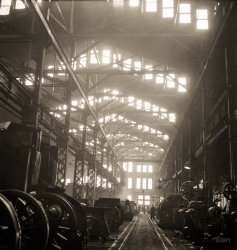
- Jackknife Bridge: 1907
- ... ago.
(The Gallery, Boats & Bridges, Chicago, DPC, Railroads) ... Posted by Dave - 08/21/2012 - 11:20am -
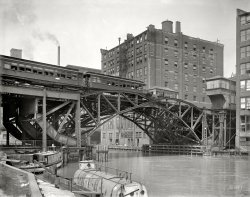
- Nebraska: 1938
- ... hostile hobos!).
(The Gallery, John Vachon, Omaha, Railroads) ... Posted by Dave - 09/14/2017 - 6:28am -
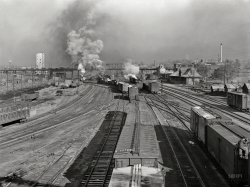
- Across the Plains: 1941
- ... complete.
(The Gallery, Landscapes, M.P. Wolcott, Railroads) ... Posted by Dave - 09/12/2019 - 8:49pm -
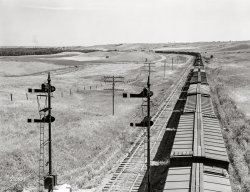
- Railway to Heaven: 1939
- ... the house is still active.
(The Gallery, D.C., Railroads) ... Posted by Dave - 09/27/2017 - 1:18pm -
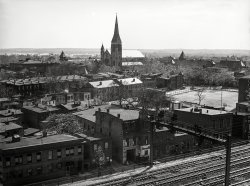
- High Bridge: 1907
- ... get to the privy.
(The Gallery, Boats & Bridges, DPC, Railroads) ... Posted by Dave - 08/09/2012 - 6:17pm -
![High Bridge: 1907 High Bridge, Kentucky, circa 1907. "High Bridge and Kentucky River." At right is a section of the stairway seen here yesterday. 8x10 glass negative. View full size.
Those houses along the banksOr rather, cabins.
I wonder who lived there and what they lived on. Those patches look way too small to be more than supplemental sustenance.
And between the bank and the foot of the escarpment it looks like every time there is high water it would be a wash-out. Thanks, I'll take the high ground and the long way around.
Still around?Is this bridge still there? I tried googling it but I'm getting a bunch of other bridges instead.
[Yes.]
General observationI'm glad Buster Keaton didn't see this photo.
For sale cheap4 houses with river view, dry almost 8 months per year, bring rubber boots and a canoe, also included a large supply of logs donated by high water for that new barn.
Nice View Of The RiverDo you think those houses ever got flooded out??!!
Yes Vinny,It's still there. Courtesy Bing 3D. And another thing: I just can't get over the beauty of this photo!
Maybe I'm crazyI realize we can't see the whole communtity, however, what a strange place to build houses. You have to get off the train and climb down those long flights of stairs, then when the river floods you have to run back up the stairs. Also, you have the critters near the water like mosquitos, snakes, rodents and belligerent loggers. A wonderful railroad site but I'd still be on that first train out of town.
[The stairs were for the use of visitors to the park and resort at the top of the cliff, not access to the riverside houses.]
Kinda Still ThereTo answer Vinny's question further: "A" bridge is still there, but not "the" bridge in the 1907 photo. The structure has been rebuilt; the stone towers are gone and the framework and supports are far heavier than before.
If you move around in the Bing Bird's eye view that rvdroz provided in the stairs photo, you can see the differences.
It was doubled-deckedYears ago on a steam train excursion that crossed High Bridge, I was told by a docent that High Bridge was widened to accommodate two tracks. He told me that that rail traffic used a temporary upper deck while the lower deck was under reconstruction!
I've wondered if I misunderstood. If it is true, I wish I could see pictures of that!
Whipple TrussBuilt in 128 days! The stone towers were originally intended for Roebling's never-completed suspension bridge. The towers were taken down in 1929 to allow for double tracks.
More photos and info at BridgeHunter: [Link 1], [Link 2].
Baltimore Sun, April 24, 1877.
An Excursion on the Cincinnati Southern Railroad.
Testing the Great Bridge.
On Friday last a delegation of Cincinnatians, representing largely the wealth and business interests of the city, made a tour of inspection of the Cincinnati Southern Railway to the Kentucky river. The road was found to be in excellent condition. The track is heavily ballasted with broken stone to the depth of fifteen inches, the ties are laid close, and the splendid steel rails, of which the whole line is to be laid, are well put down. …
The bridge was subjected to the severest tests possible, which it stood admirably, the deflection of the spans, with a weight upon them of 1,082,000 pounds, ranging from three inches down to three-quarters of an inch. This bridge is believed to be the highest railroad bridge in the world, standing as it does 275 feet above the river. Its trestles, 87 feet high, rest upon iron piers 175 feet in height, which in turn stand upon huge stone abutments 66 feet and high and 130 by 17 feet. The three spans are 375 feet each in length, though the middle section really reaches past the pier a considerable distance on each side, receiving the other sections in telescopic form. The cost is $404,000, the builders the Baltimore Bridge Company. The work was begun October 16 and ended February 20. The bridge is known as the Whipple truss double intersection girder, or continuous cantilivers. The whole structure is wrought iron. …
Stand By MeIs this the bridge Vern dropped his comb off?
This OneThis one goes in the wallpaper file for sure. Thanks Dave!
About Those HousesI did a little traveling via Google maps and discovered an Old Saw Mill Road above those cliffs.
Could they have been used for work crew temporary housing when there was a load of logs to be wrangled?
For those who wish to return to the days of yore just check the distance you would have had to travel on a sleety February night to get to the privy.
(The Gallery, Boats & Bridges, DPC, Railroads)](https://www.shorpy.com/files/images/SHORPY_4a13859a.thumbnail.jpg)
- Mission San Gabriel: 1912
- ... gotten taller.
(The Gallery, DPC, Los Angeles, Railroads, Streetcars) ... Posted by Dave - 07/25/2019 - 2:02pm -
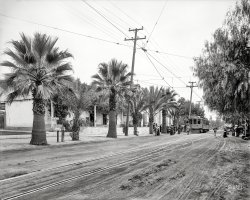
- Coal Hole: 1938
- ... near Welch, WV.
(The Gallery, M.P. Wolcott, Mining, Railroads, Small Towns) ... Posted by Dave - 03/26/2019 - 12:17am -
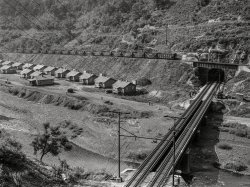
- Bisbee From Above: 1940
- ... many a former mining boom town.
(The Gallery, Mining, Railroads, Russell Lee, Small Towns) ... Posted by Dave - 08/09/2018 - 12:55pm -
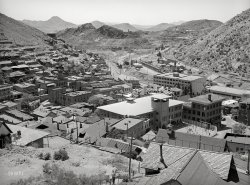
- Cannery Bro: 1908
- ... shotgun and gas money.
(The Gallery, Lewis Hine, Railroads) ... Posted by Dave - 04/19/2017 - 3:01pm -
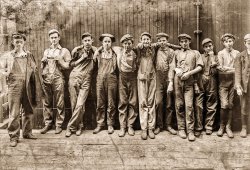
- Cuyahoga Lift Bridge: 1910
- ... water transportation corridor that fuels that haze and the railroads that needed to cross that corridor badly enough to spend the money to ...
(The Gallery, Boats & Bridges, Cleveland, DPC, Railroads) ... Posted by Dave - 10/13/2018 - 10:36am -

- Central Station: 1901
- ... a night-time view, below).
(The Gallery, Chicago, DPC, Railroads) ... Posted by Dave - 04/24/2018 - 1:57pm -
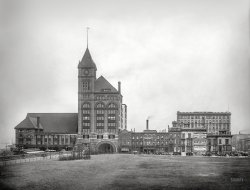
- Gravy Train: 1941
- ... flag-free in both pictures
(The Gallery, Kodachromes, Railroads, Russell Lee) ... Posted by Dave - 05/28/2018 - 5:03pm -
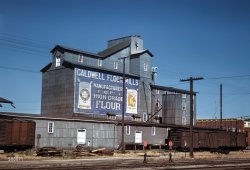
- Working on the Railroad: 1901
- ... of the New York Central.
(The Gallery, Chicago, DPC, Railroads) ... Posted by Dave - 02/16/2018 - 11:59am -
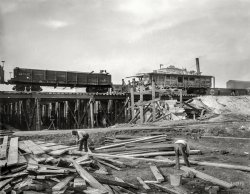
- Carnegie Steel: 1905
- ... Monthly. January, 1868)
(The Gallery, DPC, Factories, Railroads) ... Posted by Dave - 07/01/2014 - 2:47pm -
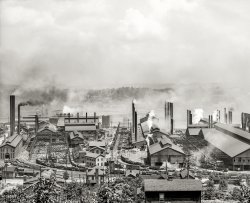
- The Green Book: 1910
- ... not on the road of Anthracite.
(The Gallery, DPC, Railroads) ... Posted by Dave - 01/21/2011 - 2:04pm -
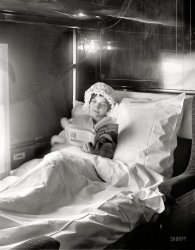
- Payday: 1905
- ... good 45 minutes.
(The Gallery, Boats & Bridges, DPC, Railroads) ... Posted by Dave - 02/11/2013 - 9:53am -
![Payday: 1905 Circa 1905. "Payday at the shipyard -- Newport News, Virginia." Where do I sign up for direct deposit? 8x10 glass negative, Detroit Publishing Co. View full size.
Okay you mugsline up alphabetically!
You can tell who's got their payThey're the ones walking purposefully away from the crowd. Off to the pub!
Back In the DayPayment in hard cash. Seems like there would have been a better way, but of course the company doesn't care, these guys are off the clock!
[I think they all felt better getting cold, hard cash. - tterrace]
Question of the DayIs this the end of the line?
PaydayThere weren't this many people in my home town.
Orderly chaosUpon closer inspection, things may be a little less chaotic than they first appear. There are multiple pay stations, and the signs at each station seem to indicate which positions get paid there (e.g. fitters, carpenters, drillers, etc.) and during what hours. So, if you were a Power House worker, you'd show up at Pay Station 3 at the designated time and your pay would be waiting; the folks in the Repair Department would have to wait until later to pick up their pay at that same window. (I wonder what happened if you showed up after your pay session ended?)
Bigger than a lot of towns in Virginia When I first moved to Newport News (1976)The shipyard employed 36,000 workers on three shifts. The majority worked days, of course and the rest were split between swing and graveyard shifts.
If you were downtown for some reason, other than working at the shipyard, You made sure that you were either on your way home before 4PM (when the yard let out) or had a good reason to stay till around 5 PM. Traffic West on Warwick Blvd and Jefferson Ave. was bumper to bumper for a good 45 minutes.
(The Gallery, Boats & Bridges, DPC, Railroads)](https://www.shorpy.com/files/images/SHORPY_4a12461a.thumbnail.jpg)
- Either Ore: 1943
- ... a busy town it was.
(The Gallery, Fritz Henle, Mining, Railroads, WW2) ... Posted by Dave - 02/08/2018 - 10:41am -
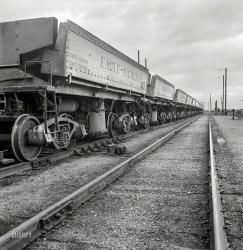
- Over the River: 1905
- ... floats, pier floats, ferries, tugs, etc. once owned by the railroads that served NY harbor, very few remain.
To my knowledge, only ONE ... harbor.
(The Gallery, Boats & Bridges, DPC, NYC, Railroads) ... Posted by Dave - 02/23/2017 - 1:27pm -
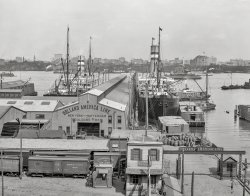
- Chicago: Night: 1943
- ... over.
(The Gallery, Kodachromes, Chicago, Jack Delano, Railroads) ... Posted by Dave - 08/05/2012 - 9:28am -
![Chicago: Night: 1943 Illinois Central freight cars at the South Water Street terminal, Chicago. May 1943. View full size. 4x5 Kodachrome transparency by Jack Delano.
Nights were darker back thenIt's interesting to compare this photo with the nighttime scene in any modern city - nowadays there are so many lights in the office buildings, while back then the offices were pitch black at night.
It seems there is a lit plane flying past the tower on the left...
[This was during World War II. There were blackout regulations in a lot of big cities, though mostly on the East Coast. - Dave]
Night photoGreat composition of light & dark, Jack sure knew how to take great photos. It looks like the boxcar is lit up by an auto's headlights.
[Jack used a floodlight. - Dave]
Line in upper left?What is that? Were commercial planes that common in 1943 like tsturm suggested?
[Aircraft running light? Whether military, civilian or interplanetary, it's hard to say. - Dave]
My guessThere are at least two streaks here, in the same trajectory. This glow is later dusk, nautical twilight, while these streaks are stellar in origin. The bright object is Venus.
This being shot in May, the zodiac would appear to be dipping to the northwest. Given that the Chicago skyline was west of the lake, and the railway ran along the Lakeshore back then, this is facing west-northwest.
Kodachrome of that day was either ASA8 or ASA10 speed, which is incredibly slow. Also, Kodachrome has poor reciprocity failure, meaning that it requires much more time to make very long exposures like this. Even time exposures with Kodachrome 64 in 2010 is pretty slow.
(Just to be sure, I pulled up Astroviewer.com's interactive night sky viewer, plugged in May 15, 1943, 8:50p CST, Chicago, and Venus is indeed in the western sky; the dimmer star is probably Theta Aurigae).
Nerd time over.
(The Gallery, Kodachromes, Chicago, Jack Delano, Railroads)](https://www.shorpy.com/files/images/1a34790u.thumbnail.jpg)
- Santa Fe Brakeman: 1943
- ... to slow things down.
(The Gallery, Jack Delano, Railroads) ... Posted by Dave - 06/11/2009 - 11:35am -
![Santa Fe Brakeman: 1943 March 1943. "Brakeman H.B. Van Santford riding on top of the caboose as the train on the Atchison, Topeka, and Santa Fe Railroad goes down from Summit to San Bernardino, California. The swing and head brakeman also ride on top of the cars for the entire distance." Nitrate negative by Jack Delano. View full size.
Fresh Air RideDoes anyone know why the three rode outside? It seems as though it would have been easier to keep that cigarette lit while inside.
Railroad storyI walked up to a brakeman
Just to give him a line of talk
He said if you've got money boy
I'll see that you don't walk
I haven't got a nickel, not a penny can I show
He said get off you railroad bum
And he slammed that boxcar door
-- "Singing Brakeman," Jimmie Rodgers
Perhaps a Little GrandstandingAutomatic air brakes eliminated the need for brakemen to run across the tops of cars applying and releasing brakes at the command of whistle signals from the locomotive. However, Mr. Van Santford does cut a gallant figure as he peers ahead looking for hot brakes or other mechanical ailments.
[Or maybe the descent from Summit required extra caution. - Dave]
Be AwareDo not confuse the Santa Fe Brakeman with the Wichita Lineman.
Life Imitates PublishingIt's right out of Jack Kerouac, from the time when he was writing about being a brakeman in California.
These days nobody gets to be on top of the train. That's less from safety rules than from the fact that they've eliminated the crews. "A train without a caboose is like a sentence without a period."
Up on the RoofAs noted in the caption, the train is descending a grade and the train carries three brakemen – head end riding the engine, rear who normally rode the caboose and "swing" riding mid-train (another Delano photo shows a swing brakeman riding and standing on a car roof as the train goes downgrade, which was standard practice here.
Brakemen would ride the roofs to watch for any sign of trouble (over-heated or burning journals ("hotbox"), burning brakes, line-side fires etc) — in this era, cars still had roofwalks and high-mounted handbrake gear, so if there was a failure or problem with the airbrakes as they descended, they could move from car to car and set the handbrakes in an effort to slow things down.
(The Gallery, Jack Delano, Railroads)](https://www.shorpy.com/files/images/8d27585u.thumbnail.jpg)
- Bagdad: 1943
- ... names are used today).
(The Gallery, Jack Delano, Railroads) ... Posted by Dave - 09/05/2012 - 6:07pm -
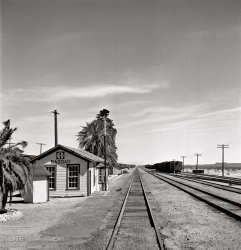
- Wabash Station: 1905
- ... is necessary.
(The Gallery, DPC, Pittsburgh, Railroads) ... Posted by Dave - 08/03/2012 - 1:45pm -
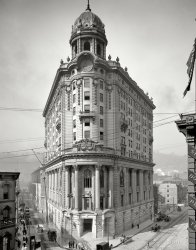
- Nice Tie: 1941
- ... missed "Honest Abs"? Shame!
(The Gallery, John Vachon, Railroads) ... Posted by Dave - 06/12/2020 - 1:56pm -
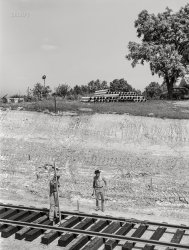
- D.R.T.: 1910
- ... they? Thank you.
(The Gallery, Detroit Photos, DPC, Railroads) ... Posted by Dave - 09/17/2018 - 10:08am -
